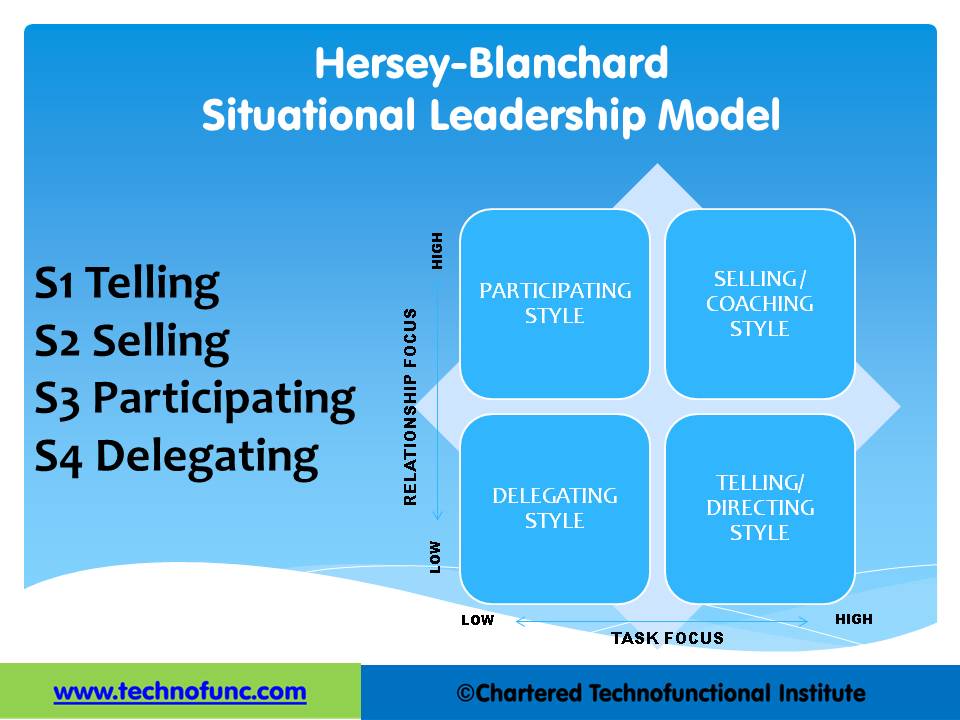- Home
- Business Processes
- Industry Knowledge
- Aerospace Industry
- Automotive Industry
- Banking Domain
- BFSI Industry
- Consumer/ FMCG Industry
- Chemicals Industry
- Engineering & Construction
- Energy Industry
- Education Domain
- Finance Domain
- Hospitality Domain
- Healthcare Industry
- Insurance Domain
- Retail Industry
- Travel and Tourism Domain
- Telecom Industry
- Leadership Skills
- eLearning
- Home
- Leadership
- Leadership Theories
- Situational Leadership Model
Situational Leadership Model
The Hersey and Blanchard Situational Theory model suggests that a leader must adapt his leadership style based on task and relationship behaviors appropriate to the situation. Leadership style is dependent on the maturity level and abilities of followers. Under this model, successful leadership is both task-relevant and relationship-relevant.
Situational Leadership Theory:
This theory was based on 3-D management style theory and has been refined several times since the time of its inception and focuses on leadership styles based on situations. Situational leadership is a style in which the leader or the manager must adjust his style to match the development level of the followers he is leading. The situational leadership model views leaders as varying their emphasis on task & relationship behaviors to best deal with different levels of follower maturity. Hence from this perspective, an effective leader has the capability to adapt his style to the demands of different situations, directing and supporting as the need may be.
Situational Leadership Behaviors:
According to Paul Hersey and Ken Blanchard’s theory on situational leadership, there are four leadership styles (S1 to S4) that match the development levels (D1 to D4) of the followers. The four styles suggest that leaders should put greater or less focus on the task in question and/or the relationship between the leader and the follower, depending on the development level of the follower. This behavior pattern can be further classified as
Directive (task) Behaviors: Task behavior reflects how much a leader is concerned with the actual task at hand and ensuring that those following him complete it. Directive behaviors help followers accomplish goals by getting clear directions, establishing their goals and objectives, evaluation criteria, time lines, roles, responsibilities and specific sub-tasks to achieve the goals. Other activities associated with directive behavior are guiding and structuring followers’ activities, planning, scheduling, and assigning responsibilities, defining roles and communication patterns for followers, motivating and conveying expertise, monitoring and following up on assignments, clarifying expectations, goals, and work methods. Directive behaviors is most of the times is one-way communication that specifies what is to be done and the task can be accomplished and assigning the responsibility for doing it. From the follower’s perspective this kind of behavior provides role clarity, clear expectations, satisfaction with work and supervisor, satisfaction with organization, lower stress and increased performance.
Supportive (relationship) Behaviors: Relationship behavior reflects how much a leader is concerned for the people around him, providing support and encouragement for them. Supportive behaviors help followers feel comfortable about themselves, their coworkers, and the situation. Examples of supportive behaviors include asking for input, solving problems, praising, sharing information about oneself, listening, being considerate and understanding, helping followers to develop abilities and careers, showing trust and respect, being sympathetic to other’s problems, being friendly, informative, and encouraging and overall showing concern for followers needs. Supportive behaviors generally involve two-way communication and intended to show social and emotional support to the followers. Supportive leadership behavior satisfy people’s needs to be liked and appreciated by others, to be respected as capable and valuable, and to be continually improving. This behavior also helps keep a group together by promoting cohesion among members and keeping individuals from becoming alienated.
Situational Leadership Styles:
Among the most successful leadership models is a group characterized as situational models as they recognize that there is not one best way to lead and effective leaders adapt their behaviors to each unique situation. Thus, a leader will be very directive in one set of circumstances, yet delegate an entire project in another. According to Hersey and Blanchard, there are four main leadership styles given below:
Telling (S1) – Telling/Directing Style:
This style (S1) is a high directive–low supportive style and generally referred to as directing style or telling style. This style is autocratic style focused on high task/low relationship. Leader defines the roles of followers and tells them what, when, where, and how to do different tasks. One way communication flows from the leader to the followers. Leaders tell their people exactly what to do, and how to do it. In this approach, the leader focuses his interactions with followers on goal achievement, and spends a smaller amount of time using supportive behaviors. Using this style, a leader gives instructions about what and how goals are to be achieved by the subordinates and then supervises them personally. This style is used at length within the law enforcement and military communities as well as on manufacturing assembly lines, providing a means of managing a diverse group of people that span a wide range of experience and maturity levels. This style is generally appropriate for professionals who are in early stage of their career and need to learn organizational behaviors.
Selling (S2) – Selling/Coaching Style:
This style is generally referred to as selling or coaching approach and is a high directive–high supportive style. The leader behavior is high task/high relationship. Leaders provide information and direction, but there's more communication with followers. Leaders try to "sell" their message to the followers to make them understand what is important for the organization. Leaders still provide information and direction, but there's more communication with followers. Leaders "sell" their message to get the team on board. In this approach, the leader focuses communication on both achieving goals and meeting subordinates’ socio-emotional needs. The coaching style requires that the leader involve with subordinates by giving encouragement and soliciting subordinate input. A perfect example of this type of leadership is often found in an internship situation, with the success of this approach dependent upon whether the student or apprentice learner is excited and self-motivated to be on the job. However, coaching is an extension of S1 and still requires the leader to make the final decision on the process and how of goal accomplishment.
Participating (S3) – Participating Style:
Style S3 is referred to as supporting or participating style that requires that the leader take a high supportive–low directive style. This style is high relationship/low task focus. Leader focuses more on the relationship and people and less on direction. The follower is empowered to make many of the decisions since he has the knowledge to do so. There is high level of trust and communication between the leader and the follower. Leaders focus more on the relationship and less on direction. The leader works with the team, and shares decision-making responsibilities. The supportive style includes listening, praising, asking for input, and giving feedback. A leader using this style gives subordinates control of day-to-day decisions but remains available to facilitate problem solving. In this approach, the leader does not focus exclusively on goals but uses supportive behaviors that develop employees’ skills around the task to be accomplished. Leader appreciates the work done and is quick to give recognition and social support to followers. This style is often used by corporate leaders who are attempting to influence a board of directors toward developing a new policy for which there is no proven history or established practice.
Delegating (S4) – Delegating Style:
Style S4 is called the low supportive–low directive style, or referred to as delegating approach. It is considered as low relationship/low-task leader behavior. Leader passes most of the responsibility onto the followers. The leaders still monitor progress, but they're less involved in decisions. The style involves letting followers “run their own show”. Leaders pass most of the responsibility onto the follower or group. The leaders still monitor progress, but they're less involved in decisions. In this approach, the leader offers less task input and social support, facilitating employees’ confidence and motivation in reference to the task. The delegative leader is involved very less in planning, detailing and clarification and leaves it for the group to agree on what and how to accomplish. In this style subordinates need to take responsibility for getting the job done the way they seem fit as leader has already given the control to subordinates to decide. The leader generally refrains from intervening with unnecessary social support. This style is seen commonly in the freedom given to tenured professors who are allowed to lead in the manner they believe is most effective while being monitored by a dean or department head.
Maturity Levels / Development Levels:
The second part of the situational leadership model defines the developmental or maturity levels of subordinates. It is the degree to which subordinates have the competence and commitment necessary to accomplish a given task or activity. According to Hersey and Blanchard, maturity levels can be broken down into four different levels and they are based on the task at hand and should not be used to classify followers:
Employees are at a high development/maturity level if they are interested and confident in their work and know how to do the given task. Employees are at a low development level if they have little skill for the task at hand but believe that they have the motivation or confidence to learn and get the job done.
|
Development Levels |
Maturity Levels |
Attributes |
Leadership Style |
|
D1 |
M1 |
Low in competence, high in commitment, lack knowledge, skill and confidence, need to be pushed and supervised, new to a task, excited about the challenge of it. |
S1 |
|
D2 |
M2 |
Some competence, Low commitment, Started to learn a job, lost some of their initial motivation, willing to work, cannot independently take responsibility for the work. |
S2 |
|
D3 |
M3 |
Moderate to high competence, lacks commitment, Developed the skills for job, uncertain as to whether they can accomplish the task by themselves, experienced, ability to perform tasks independently but lack confidence. |
S3 |
|
D4 |
M4 |
Highest in development, high degree of competence, high degree of commitment, skills to do the job, motivation to get it done, high abilities and confidence, willingness to take individual responsibility of the tasks. |
S4 |
Steps in Situational Leadership Approach:
According to this theory instead of using just one style, successful leaders should change their leadership styles based on the maturity of the people they're leading and the details of the task.
Based on the situational leadership theory, an effective leader will follow the following steps to decide upon the appropriate leadership style for a given situation:
1. The first step is to evaluate the employees and assess their competency levels and commitment levels to perform the given task. This can be observed over a period of time.
2. Identify employee’s current motivation and skills level to handle the organizational tasks or responsibilities assigned to him.
3. Based on the assessment understand the need of the employee for either directive leadership or supportive leadership or a mix of both. Leaders need to identify whether they should place more or less emphasis on the task, and more or less emphasis on the relationships depending on the demands of the task/responsibilities of the job at hand.
4. Flex your leadership style to meet the changing needs of employees/followers to accomplish the task successfully.
Situational Leadership is a registered trademark of the Center for Leadership Studies.

Related Links
Explore Our Free Training Articles or
Sign Up to Start With Our eLearning Courses

About Us
Learning
© 2023 TechnoFunc, All Rights Reserved
